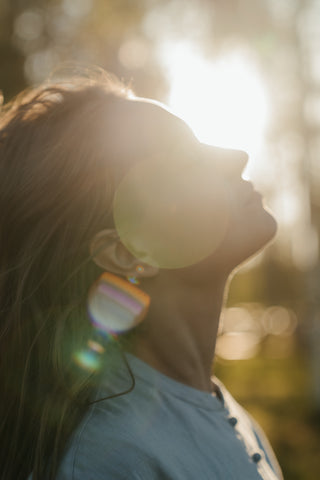Yep, you read that right.
Sunshine isn’t the enemy. It’s fundamental.
It needs to be on your bare skin and in your eyes– often.
This probably goes against every piece of advice you’ve ever heard about the sun.
“Wear sunscreen daily to prevent wrinkles, sunburn, and skin cancer.”
“Reapply every two hours just to be safe”
“Use at least SPF 15, even on cloudy days.”
We’re told to avoid the sun as much as humanly possible if we want to be healthy.
But where does this advice stem from? And what’s the truth about the sun?
Keep scrolling to learn why our bodies crave barrier-free rays and how to practice safe sunning.
The history of sunscreen– is it truly necessary?
Our ancestors spent millennia working, playing, and living under the sun.
They stayed outdoors during daylight hours, wore natural fiber clothing, knew when to seek shade, and used the sun as a seasonal guide.
Crazy thing is, they didn’t slather on Banana Boat or Supergoop! *gasp*
Instead, they were in tune with their bodies and lived in harmony with the sun.
Unfortunately, as each generation spends more time indoors, our skin has become less resilient.
The sun damage discussion came up just in the last century or so– right around the time our collective diet shifted to include more polyunsaturated fats and fewer ancestral foods.
The first modern sunscreen was introduced in 1946 by Swiss chemist Franz Greiter. (1)
Nowadays, sunscreen is considered an essential step in a healthy skincare routine, and our store shelves are lined with hundreds of options.
From dry-touch and water-proof to ultra-sheer and organic, there’s literally something for everyone.
But with more sunscreen than ever before, we’ve also seen a steady climb in immune disorders and skin cancers.
Something isn’t adding up.
Newer research reveals that our fear of the sun might just be to blame for this jump in diagnosis. (2)
Why most sunscreens cause more harm than good.
While early sunscreens contained more saturated fats like coconut and olive oil, manufacturers eventually switched to cheaper petroleum-based chemicals and polyunsaturated oils.
This poses a problem because these ingredients are often endocrine-disrupting, highly oxidative, and even carcinogenic. (3)
Petroleum contains xenoestrogens that can lead to estrogen dominance in the body and hormone imbalance. (4)
And polyunsaturated fatty acids are known to easily oxidate when exposed to air and light, which can raise oxidative stress in the body.
Dr. Ray Peat found that accumulating PUFAs in the body and skin leads to accelerated aging and cellular damage. (5)
And typically, you only reach for sunscreen when you’re outside, exposed to high amounts of both these elements.
An ironic choice for a sunscreen formula– don’t you think?
What about natural sunscreen? Non-nano zinc oxide?
With increased awareness of the toll certain chemicals take on hormonal health, we’re seeing plenty of more natural sunscreens enter the scene.
Though they are less toxic and provide some protection by reflecting ultraviolet rays, they aren’t exactly the skin savior they’re made out to be.
Non-nano zinc oxide is highly charged and easily clumps in most formulas– leaving gaps in protection. (6)
These particles also have the potential to reflect and even magnify ultraviolet rays on some parts of the skin.
But the biggest issue we have with sunscreen, in general, is it provides a false sense of security, so you end up staying in the sun longer than you normally would.
It disconnects us from our innate ability to know when enough is enough.
You end up burning worse than if you went bare-skinned. Go figure.
We need direct sun exposure to thrive.
Contrary to popular belief, sunlight is therapeutic for the human body.
Our biology is intricately linked to the sun’s daily rhythms– setting our internal clock for healthy sleep cycles and balanced hormones.
Without it, things like seasonal depression and skin problems become the norm.
Just as we need nutrient-dense foods, clean water, and adequate rest– getting enough daily sunlight lays the foundation for our overall health.
And it’s certainly not something to be feared.
The sun helps your body make vitamin (hormone) D.
The cat’s out of the bag.
Vitamin D is actually a hormone because, unlike other vitamins, it needs to be activated for the body to use it.
Just another reason to question the fortification of foods.
How it works: cholesterol in the skin absorbs ultraviolet rays from the sun and converts them into the active form of “vitamin” D.
This fat-soluble nutrient is needed to properly absorb and retain calcium and phosphorus, build strong bones, and bolster immunity.
What are the health benefits of sun exposure?
-
metabolically supportive
The entire endocrine system hinges on the sun. When wavelengths reach your brain, it triggers reactions that regulate everything from the thyroid gland to your reproductive organs. Resulting in higher basal body temperatures, increased energy, and optimized metabolism. (7)
-
mental wellness
Ultraviolet waves have both a stimulating and homeostatic effect on the nervous system through chemical, hormonal, and neural signals. Daily sun exposure can lower stress levels, calm anxiety, and release feel-good endorphins. (8)
-
immune function
Not only does sunlight help the body produce immune-boosting vitamin D, but it also activates immune cells to work more efficiently. (9) Low levels of regular UV exposure help the body prevent and attack malignant cells before leading to disease. (10)
-
infant development
Getting sensible sun while pregnant and early in your baby’s life contributes to their overall health and even height. In fact, prenatal sunlight is one of the most determinant factors of height. (11) Avoid skin burning or irritation by bringing your little one out in the sun for just 10-15 minutes in the morning and evening.
-
skin integrity and appearance
Have you ever noticed your skin looks better in the summertime? That’s because the sun lowers inflammation and reduces excessive skin shedding that causes common skin conditions like acne and psoriasis. It also boosts nitric oxide, human growth hormone, and vitamin D levels to fight bacteria, boost collagen production, and protect against oxidative stress. (13, 12, 2)
What is light hygiene?
In our modern world of indoor living and fluorescent overhead lighting, this is the elephant in the room.
Poor light hygiene can lead to a whole slew of unwanted symptoms like depression, headaches, hormone imbalance, and insomnia.
Weave these light-conscious habits into your daily life for a more balanced routine.
- Get morning and evening sunlight in your eyes and on your skin to regulate circadian rhythms.
- Step away from the screen and get outside as often as you can during working hours.
- Avoid overhead lights at nighttime that suppress melatonin– use full-spectrum lightbulbs or candles instead.
- Wear blue light-blocking glasses when working on your computer or staring at a screen.
How to practice safe sun exposure without sunscreen.
Daily sunshine is necessary, but it’s important not to overdo it.
And it’s important to remember that there is no one-size-fits-all.
Your optimum exposure depends on your skin type, where you live, and your heritage.
But here are some tips to get more rays without feeling the burn.
1. Protective natural-fiber clothing
You can shield your skin without all the chemicals. Natural fibers block UV rays while keeping the skin cool.
2. Swapt your shades for a wide-brim hat
Sunglasses increase your melatonin levels during the day and throw off circadian rhythms. (14) Opting for a wide-brim hat will shade your face while allowing indirect sunlight to touch your eyes for balanced energy and mood.
3. Sunshine breaks
Listen to your body. When you feel uncomfortable, it's time to adjust and find shade. Though sun exposure is accumulative, taking longer breaks will allow your skin to adapt and recover.
4. Limit PUFAs and fortified foods
Polyunsaturated fats increase the risk of oxidative stress on the body– and iron is fuel for the fire. PUFAs can interact with estrogen and iron from fortified foods like highly processed bread, cereal, and pasta to form a pigmented byproduct called lipofuscin. (15) This discoloration is known as the dreaded age or liver spots.
5. Consume more saturated fats
Sun protection starts on the inside. Include stable fats like tallow, butter, and eggs in your diet to lower inflammation and resist oxidation. (16)
6. Consume antioxidant-rich foods
Foods high in antioxidants, specifically vitamins E, C, and K, help your body fight free radicals and defend against oxidative damage.
7. Build your tolerance
Don’t go too hard, too fast. Bask earlier in the day or after 3 pm when the rays aren’t as strong to help your skin get used to the sun without burning.
8. Supportive, saturated skincare
If you think you’re ready to retire your sunblock and sunscreen collection– it’s important to find skin supports rooted in biology to replace it.
Speaking of support, a lot of hype is building around methylene blue as a powerful pre and post sun tool. It's shown to effectively absorb ultraviolet rays, energize the cells, and repair damage caused by oxidation. (17)
Fatskn Pre-Sun is a blend of this colorful antioxidant and a handful of other nourishing ingredients to help you get the most out of your time under the sun.
And you already know we’re obsessed with saturated fats. They’re inherently protective and help your body convert sun into vitamin D. Applying tallow, shea butter, and cocoa butter before and after sun exposure will also prevent your skin from drying out or becoming inflamed. Raw cacao butter, specifically, has natural sun-protective qualities that can filter some UV rays.
Fatskn Whipped Body Butter is a fully saturated, non-endocrine-disrupting support loaded with nourishment.
It feeds the skin from the outside and builds back resilience.
So you can finally stop fearing the sun– and start basking in it.
.
.
.
As always, while we hope to be a no-nonsense resource, we encourage you to do your own research to find the healthiest options for you and your family.
You can check out our collection of good-for-you, tallow-based skincare products by clicking the link below. We hope to see you there!
.
.
.
Resources:
1. Drissi, M., Carr, E., & Housewright, C. (2021). Sunscreen: a brief walk through history. Baylor University Medical Center Proceedings, 1–3. https://doi.org/10.1080/08998280.2021.1966602
2. Mead MN. Benefits of sunlight: a bright spot for human health. Environ Health Perspect. 2008 Apr;116(4):A160-7. doi: 10.1289/ehp.116-a160. Erratum in: Environ Health Perspect. 2008 May;116(5):A197. PMID: 18414615; PMCID: PMC2290997. https://www.ncbi.nlm.nih.gov/pmc/articles/PMC2290997/
3. Johnson & Johnson Consumer Inc. Issues Voluntary Recall of Specific NEUTROGENA® and AVEENO® Aerosol Sunscreen Products Due to the Presence of Benzene | Johnson & Johnson. (2021, July 14). Content Lab U.S. https://www.jnj.com/johnson-johnson-consumer-inc-issues-voluntary-recall-of-specific-neutrogena-and-aveeno-aerosol-sunscreen-products-due-to-the-presence-of-benzene
4. E, A. (2022, November 29). Is Petroleum Jelly Bad For You? AvaCare Medical Blog. https://avacaremedical.com/blog/is-petroleum-jelly-bad-for-you-2.html#:~:text=It%20Disturbs%20The%20Estrogen%20Level
5. Peat, R. (n.d.). Unsaturated fatty acids: Nutritionally essential, or toxic? Raypeat.com. https://raypeat.com/articles/articles/unsaturatedfats.shtml
6. RealizeBeautyEd. (2012, December 30). The Trouble With Making Your Own Sunscreen. Realize Beauty. https://realizebeauty.wordpress.com/2012/12/30/the-trouble-with-making-your-own-sunscreen/
7. Lang, R. (2020, September 2). This is Your Brain…on Sunlight. Www.cincinnatichildrens.org. https://www.cincinnatichildrens.org/news/release/2020/light-sensing-cells
8. Slominski AT, Zmijewski MA, Plonka PM, Szaflarski JP, Paus R. How UV Light Touches the Brain and Endocrine System Through Skin, and Why. Endocrinology. 2018 May 1;159(5):1992-2007. doi: 10.1210/en.2017-03230. PMID: 29546369; PMCID: PMC5905393. https://www.ncbi.nlm.nih.gov/pmc/articles/PMC5905393/
9. Phan, T., Jaruga, B., Pingle, S. et al. Intrinsic Photosensitivity Enhances Motility of T Lymphocytes. Sci Rep 6, 39479 (2016). https://doi.org/10.1038/srep39479
10. Holick MF. Vitamin D, sunlight and cancer connection. Anticancer Agents Med Chem. 2013 Jan;13(1):70-82. PMID: 23094923. https://pubmed.ncbi.nlm.nih.gov/23094923/
11. Waldie KE, Poulton R, Kirk IJ, Silva PA. The effects of pre- and post-natal sunlight exposure on human growth: evidence from the Southern Hemisphere. Early Hum Dev. 2000 Nov;60(1):35-42. doi: 10.1016/s0378-3782(00)00102-x. PMID: 11054582.
12. Queirós CS, Freitas JP. Sun Exposure: Beyond the Risks. Dermatol Pract Concept. 2019 Oct 31;9(4):249-252. doi: 10.5826/dpc.0904a01. PMID: 31723456; PMCID: PMC6830553. https://www.ncbi.nlm.nih.gov/pmc/articles/PMC6830553/
13. Sorenson, M. (2016, November 20). Sun exposure: an antiseptic and antibiotic. Sunlight Institute. https://sunlightinstitute.org/sun-exposure-antiseptic-antibiotic/
14. Crowley SJ, Lee C, Tseng CY, Fogg LF, Eastman CI. Combinations of bright light, scheduled dark, sunglasses, and melatonin to facilitate circadian entrainment to night shift work. J Biol Rhythms. 2003 Dec;18(6):513-23. doi: 10.1177/0748730403258422. PMID: 14667152. https://pubmed.ncbi.nlm.nih.gov/14667152/
15. Brunk UT. On the origin of lipofuscin; the iron content of residual bodies, and the relation of these organelles to the lysosomal vacuome. A study on cultured human glial cells. Adv Exp Med Biol. 1989;266:313-20; discussion 321-2. doi: 10.1007/978-1-4899-5339-1_22. PMID: 2486159. https://pubmed.ncbi.nlm.nih.gov/2486159/
16. Vieira SA, McClements DJ, Decker EA. Challenges of utilizing healthy fats in foods. Adv Nutr. 2015 May 15;6(3):309S-17S. doi: 10.3945/an.114.006965. PMID: 25979504; PMCID: PMC4424769. https://www.ncbi.nlm.nih.gov/pmc/articles/PMC4424769/#:~:text=Saturated%20lipids%20are%20much%20more,2%2C%208%2C%2036).
17. Xiong, ZM., Mao, X., Trappio, M. et al. Ultraviolet radiation protection potentials of Methylene Blue for human skin and coral reef health. Sci Rep 11, 10871 (2021). https://doi.org/10.1038/s41598-021-89970-2


